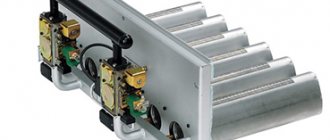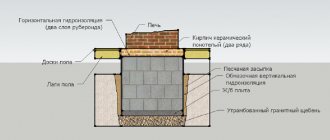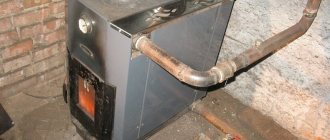The fundamental difference between a greenhouse and a greenhouse is that the first of the structures is heated by natural means, but heating the second will require the installation of an artificial heating system. Its device can be implemented in several ways. You can install electric, water or gas heating. Each of these methods has its own disadvantages and advantages. But for heating a small greenhouse, it is most advisable to use gas.
Gas is a flammable explosive, therefore heating a greenhouse with gas requires seeking help from specialists. Don't neglect this!
Heating a greenhouse is a necessary condition for growing various crops in it.
To ensure sufficient heating in autumn and spring, the most optimal method is that which is carried out using gas, since the installation of a water or electrical system under such conditions is difficult to call appropriate.
If the room is small, then there is no need to connect the heating system to the central gas supply line. You can buy gas cylinders, which will provide heating. The cylinders can simply be connected to a self-regulating heating system. A seasonal greenhouse can be heated using bottled gas; the heat they can provide is quite sufficient. Also, with gas heating, carbon dioxide and water vapor enter the room, and these substances contribute to the active growth of seedlings.
Basic Rules
In greenhouses with a large area, it is necessary to connect to a common gas pipeline network; small greenhouses can be heated with gas cylinders.
To heat a room with gas, you can use various heating equipment: gas burners or air heaters. Each of them has its own characteristics. Using burners is more dangerous. However, provided that there are no wooden elements in the greenhouse structure, you can resort to burners. In this case, the burners simply need to be connected to cylinders and placed throughout the entire area of the room requiring heating. Installing a heating system requires a lot of expense and effort, but this option will prove to be more convenient to use in the future.
Particular attention must be paid to the uniform distribution of heat in the room, as this represents the greatest difficulty when organizing gas heating. To do this, you need to connect a sufficient number of burners to the gas cylinder, which will be distributed evenly throughout the room. At the same time, providing gas heating to a greenhouse requires compliance with certain safety measures. For example, access to gas burners should not be hampered in any way. If any problems occur in their operation, it should be possible to turn them off immediately. In addition, gas equipment requires constant preventive maintenance.
Heating using gas requires an efficient ventilation system. A hood may need to be installed. This is due to the fact that gas heating leads to a lack of oxygen over time.
The advantage of air heaters is that they are able to provide a sufficient amount of heat and at the same time mix the heated air. Their only drawback is their high cost. First of all, costs will be required for the installation of polyethylene perforated pipes, which should form an entire system. In addition, it is necessary to install a chimney that will ensure the removal of combustion products from the room.
Classic version
The traditional approach to using gas to ensure an optimal microclimate in greenhouses involved the creation of a heat circuit based on a gas boiler. This method is effective and reliable, but it is not very suitable for a small private greenhouse; the financial investment turns out to be impressive; it is necessary to create complex pipe routings and install shut-off valves for fine tuning and adjustment of functioning. In addition, this method of gas heating requires obtaining numerous certificates and permits; the equipment is classified as potentially dangerous, and therefore requires approval from regulatory authorities.
As a result, this scheme is relevant only if we are talking about a large commercial greenhouse with an area of several hundred square meters. Then we can talk about the justification of all investments, they are quickly compensated. Creating a separate heating circuit for a small agricultural structure is only appropriate if the owners use a gas boiler to heat the main cottage; it is possible to make a branch to the greenhouse.
Some features
When heating a greenhouse with gas, oxygen burns out and burns out, which is dangerous for plants, so ventilation/air supply systems must also operate simultaneously with gas heating.
Heating a greenhouse with gas means turning to specialists for help. Do not neglect this, as gas is a flammable and explosive substance. Failure to take the necessary safety precautions can pose a threat to your health and even your life. If you contact a specialist in this matter, he will help you determine the optimal number of burners or heaters that will provide heating for a greenhouse of a certain size for growing certain crops.
So, the undeniable advantages that heating a greenhouse with gas have:
- efficiency;
- efficiency;
- safety (subject to professional installation by a specialist in this field, who will give recommendations on the safe operation of heating devices).
Thus, you know the basic principles of arranging a heating system using gas. Compared to other methods of heating a room for growing plants, the use of gas has significant advantages. Most gardeners prefer it. However, the heat obtained in this way may not be enough if you need to heat a large greenhouse throughout the year.
Features of modern products - a hidden threat
What is the reason? I think, first of all, in the recent publications on the pages of newspapers and magazines, as well as on television screens, about what modern sellers of “healthy” products feed us. As it turned out, for the most part, all these beautiful and appetizing delicacies do not always bring the desired benefits to the human body, and in some cases they can cause serious harm to the body, even death. In addition, it is much more pleasant to see vegetables and berries on your table that were picked just a few minutes ago from the garden, without pesticides or other chemical additives. The benefits of such products are undeniable.
Feasibility of heating greenhouses with gas
Previously, due to the lack of a sufficient number of gas heating devices on the markets, the gasification procedure was quite an expensive and troublesome affair. Most often, this approach to heating was used in greenhouses attached to residential buildings.
In this case, it was necessary to connect to a common gas pipeline, for which appropriate permits were required. In addition, we had to look for specialized companies that could perform high-quality installation and “cut” into the common gas pipeline. Given such difficulties, few people have used this approach to heating greenhouses.
Today on the market you can find a lot of different gas appliances that will provide high-quality heating of the room without the need to connect to a common gas supply system. In addition to the fact that gas heating has become more affordable, it has become possible to use it not only in greenhouses attached to houses, but also in buildings located anywhere on the site.
There is only one requirement - safety!
Currently, we have considered only two options for heating stoves for greenhouses. But there are many more options, just what does Kuznetsov’s bell-type stove for greenhouses
, or a miracle stove for greenhouses and heating garages and boxes with the funny name “Bubafonya”.
We understand perfectly well that long-burning stoves
for greenhouses are currently in great demand among the population, and we will try to write more than once about economical stoves for greenhouses on the pages of our Internet resource.
When making stoves for a greenhouse with your own hands, regardless of whether they are made of metal or a stove for a brick greenhouse, always remember that a stove is, first of all, a serious and fire-hazardous unit
. Therefore, it is worth doing all the work competently and efficiently.
Many gardeners begin planting greens and seedlings as early as March. The favorable temperature for their growth is +18 degrees. In most regions, the thermometer does not reach this level. This is possible in a greenhouse with additional heating. The situation changes if you make a stove for a polycarbonate greenhouse with your own hands.
Advantages of gas heating for greenhouses
- The main advantages of gas heating of a greenhouse are:
- high level of efficiency of such equipment - less energy is absorbed than generated;
- the ability to heat a fairly large area;
- no need to search for a place to store fuel, for example, as for diesel and solid fuel boilers;
- When gas is burned in modern installations, the optimal amount of carbon dioxide is released, which is necessary for the normal functioning of plants;
- long service life - from 15 to 50 years, depending on the type of equipment and material used to create it;
- absence of noise during system operation;
- easy maintenance of equipment.
Classification of gas heating systems for greenhouses
Gas heating equipment varies in type of design and method of operation.
Depending on this, they are divided into 3 groups:
- infrared;
- catalytic;
- convector.
In addition, there are gas-air and gas-water systems. Not every device is suitable for heating a greenhouse, so you should consider the most appropriate systems to use for such premises.
- Namely:
- heaters with open burners;
- convectors;
- systems operating on gas with infrared burners.
Open burner heaters
Designs of this type consist of a thermostat, as well as two burners - the main one and the pilot one. The devices operate by connecting to a gas cylinder or portable gas heater (you can, for example, use TAG-50).
The essence of the work is that the heated air rises to the top of the building, and, having cooled somewhat, falls into the plant growing zone, thereby creating optimal microclimatic conditions.
A significant disadvantage of the installation is the combustion of a large amount of oxygen inside the greenhouse, which can negatively affect the condition of the vegetation. To establish proper gas exchange, ventilation must be adjusted. You can get by with a basic exhaust system.
Gas convectors
This type of equipment usually consists of:
- housing - its main function is to protect the room from open fire, so it is made of heat-resistant materials;
- heat exchanger - its main task is to heat the air in a short time, due to the release of its own heat obtained as a result of heating by fire;
- gas burner - consists of an ignition and main part, located inside the heat exchanger;
- combination valve - provides pressure regulation;
- combustion product removal systems;
- thermostat - controls the microclimate by maintaining the set temperature at a constant level;
- automation systems - responsible for analyzing the operation of the entire system as a whole, eliminating emergency situations (turning off the gas supply in the event of a malfunction).
Regarding combustion product exhaust systems, gas convectors are divided into fireplace and parapet. In the first option, air masses from the room enter the heat exchanger, and combustion products are discharged through a vertical chimney to the street. This exhaust system is typical for a conventional oven.
Parapet convectors are more environmentally friendly in this regard. Air and combustion products are taken in through a coaxial pipe laid through the outer wall. The pressure in the pipe is maintained by a built-in fan.
The essence of the device’s operation is the same as in the previous version, but is carried out using automation. Due to the fact that cold air concentrates in the lower part of the building, as well as near windows and doorways, it is more advisable to install it in close proximity to these areas.
A household heat generator of this type is well suited for installation in a room with a gas supply system. For example, in a greenhouse attached to a house or intended for the production of products on an industrial scale.
Long-burning wood-burning stove
You can heat a greenhouse without constantly adding fuel using a wood-burning greenhouse. Similar to the sawdust unit, fuel must be added in the morning and evening for round-the-clock heating. However, it all depends on the volume of the stove, which can be calculated so that one load of firewood is enough for a day. This design is popularly called Bubafonya. You can buy it, but it’s not difficult to assemble it yourself.
A long-burning stove does not have a combustion chamber. The logs are laid on top and tightly covered with a disc-shaped weight. Its diameter practically coincides with the diameter of the body. This disk has a round hole into which a pipe is welded. It is through this that air is supplied for fuel combustion.
A chimney emerges from the top of the body, into which a damper is built in to regulate the draft. The weight lowers as the logs burn, ensuring that the firebox is always full. Thus, the fuel burns from top to bottom, which ensures slow smoldering and within 12-14 hours a medium-sized stove heats the greenhouse.
How to pipe gas into a greenhouse with your own hands?
If you plan to connect to a common gas pipeline, you cannot deal with this issue yourself. First of all, you should contact the relevant organizations to obtain permission and draw up a plan. After this, you need to invite a professional gas fitter who will carry out the work according to the established instructions and issue the relevant documents.
For self-installation of gas heating in a small, free-standing greenhouse, it is best to use the option with infrared burners. It is easier to install. To begin with, you need to decide on the installation location. The market offers models designed for ceiling, parapet, wall mounting and mobile.
Then you should start organizing the ventilation system. It can be made from PVC pipes with a cross-section of 10 cm. At one end of the building, the pipe is fixed so that it rises 50 cm above the roof level.
On the opposite side, the pipe is mounted so that its lower end is located at a level of 1 m from the soil, and extends 10 cm beyond the roof level. Thus, one pipe will serve to supply air, the other will serve to remove it from the room.
Next, the devices themselves are installed. Basic requirements for their installation:
- There must be at least 1 m from the soil level to the equipment.
- A distance of at least 1 m must also be maintained to the plantings and from the heater.
- If you need to place several IR devices, then they are installed at a distance of 0.5 m from each other.
When connecting equipment to gas cylinders, all actions are quite simple. A hose is connected to the reducer on the cylinder and secured to the equipment. All fixation points are reinforced with clamps.
Video: Installing infrared heaters in a greenhouse
Option #1. Brick oven with hog - the old fashioned way
It is better to build massive stoves for greenhouses exclusively using wood with a hog - this is a horizontal pipe with a rise along the flue gases, which provides good draft. To build such a stove for heating your greenhouse, you need to get a couple of old iron pipes and at least two iron slabs from old brick stoves, plus about four hundred stove bricks - new or used, it doesn’t matter.
So, the first thing you need to do is build a foundation for such a furnace - preferably monolithic, along the entire length. It should not “walk” - otherwise cracks in the walls will not be avoided. It can be made from concrete, or you can do it this way: firmly connect two slabs with a frame made of pipes.
In the upper part of the firebox, you need to install two pipes to allow air to pass inside the greenhouse. The draft will always be created due to the fact that the air in the greenhouse is rarefied - it goes to burn wood in the firebox. It is only important that the cleaning door is tightly closed. From the greenhouse itself, air will pass through the side pipes into the blower chamber, and the pipes themselves will be connected to the channels. Air will enter the channels through the air intake, and then warm the soil in the side beds.
We place a water tank above the firebox - in early spring there will always be warm water for irrigation, and on hot days there will be additional moisture for cucumbers and peppers. This stove will be heated from the street. And to clean these channels, there is a special door and a pit at the bottom of the riser where you can rake the soot. It is convenient to do this with a stiff brush on a long handle.
Safety precautions when connecting gas
If it was decided to use gas cylinders for heating the greenhouse, safety precautions must be observed when connecting them to devices:
- After connecting the cylinder through the reducer to the equipment and securing the clamps, check for leaks. To do this, cover all connections with soap foam (any kind will do). If the formation of bubbles is observed, then there is a leak, and therefore it is necessary to tighten all connections again and carry out the control act again.
- Place the gas cylinder 1 m away from the heating device.
- Do not check the tightness of connections using burning paper or similar tricks.
- When filling a cylinder, the volume of gas in the container should not exceed 85% of the total in order to avoid an increase in internal pressure.
Gas heating in greenhouses today is an affordable and economical heating option, allowing you to obtain crops all year round. The main thing is to choose the right equipment and observe safety measures during its subsequent operation.
A gas heater for a greenhouse will provide the seedlings with the necessary heat, allowing you to start heating as soon as necessary. It gained popularity due to its portability and relative cheapness, thanks to which even the seasonal use of a personal plot does not become a significant shock to the family budget. In order to fully enjoy the benefits of a gas heating system, you should study all the technical nuances of structures of this kind.
Oven - solution to the problem
Many areas of our country, due to climatic conditions, are not predisposed to growing heat-loving plants. The latter simply do not have time to mature. But you can grow excellent vegetables all year round in your greenhouse plot. How? The answer is simple - use a greenhouse stove.
Stoves for heating greenhouses allow you to harvest crops all year round, even in areas with a cold climate.
Expensive doesn't mean impossible
Understanding that a stove for a greenhouse requires the use of energy resources and their high cost, we want to devote this article to the question of how to make a stove for a greenhouse using fuel with your own hands, the purchase of which involves minimal costs, and in some cases will not cost you at all no costs. Do-it-yourself greenhouse stoves should be economical, easy to operate and use available fuel.
Fuel - take a look around
Unreal? You are wrong. So where to start? If you already have a small greenhouse on your site, it’s time to take care of its heating. First of all, you need to decide on the type of fuel that your stove will use to heat the greenhouse. Option one: there are woodworking companies near you. This is not uncommon in our northern regions. The main waste from such enterprises is wood chips and sawdust. This means that it is most profitable to build a stove using sawdust with your own hands.
Sawdust - simple and long lasting
But heating a greenhouse in cold weather requires constant operation of the stove. This means that we will need to build a stove that, while heating the greenhouse around the clock, will consume a minimum amount of fuel and with one or two refills. In other words, you will need a stove for a long-burning greenhouse. The picture shows a stove burning sawdust.
Almost anyone can make this long-burning stove with their own hands in literally one day. At the same time, the stove perfectly heats the greenhouse room.
How to make gas heating for a greenhouse
Only a properly selected gas heater will cope with the task. The first classification system is based on the use of a water or gas-air heating unit. In the second case, warm air moves in special air ducts. Another classification system is based on the number of built-in heat sources.
For small greenhouses, a 1-phase is suitable, and for larger ones, a multi-phase greenhouse heater is suitable. If we talk about the advantages of both options, then it is preferable to choose the second one.
This is explained as follows:
- Small heat sources are installed along the entire perimeter of the building, which promotes uniform heating;
- If the region experiences sudden cold snaps, then the multiphase version of the heater is supplemented with a catalyst system;
- An IR heater will help smooth out high humidity and a high difference between night and day temperatures.
Types of stoves + comparison of fuel options
The design features of stoves depend on the dimensions of the room.
Devices differ according to the dominant criteria for the thermal effect they provide, which include:
- infrared radiation;
- heat transfer;
- convection.
In the oven it is customary to distinguish:
- fuel combustion chamber;
- air flow channels;
- convection shirt;
- additional components.
The following can be used as fuel:
- electricity;
- wood shavings (pressed sawdust);
- peat;
- coal;
- firewood;
- oil-based fuels.
Firewood is affordable. They are a slow burning fuel option.
Coal has a high calorie content. However, its use is limited due to the presence of large amounts of waste, the formation of potentially hazardous substances during use, and the ability to spontaneously combust.
The use of sawdust is justified from the point of view of low cost, environmental friendliness, rapid combustion, minimal smoke and high efficiency. The principle of use is based on their slow smoldering, due to which the greenhouse is heated for a long time.
Tips for beginning gardeners: how to install gas into a greenhouse
Lucky are those whose greenhouse is located in close proximity to their home. In this case, you can heat the seedlings with gas with minimal time and effort. The situation is more complicated when it is impossible to install a gas pipeline to the greenhouse.
Mobile sources of gas - cylinders - will help to get out of this situation. Our review will help you choose a gas heater: https://homeli.ru/stroitelstvo-doma/inzhenernye-sistemy/otoplenie/gazovye-obogrevateli. When using them, you must always monitor the concentration of carbon dioxide in the greenhouse.
If there is too much of it or vice versa, the seedlings will not grow. You can assemble the simplest gas circuit as follows. First, you need to decide whether gas will be supplied to the house and greenhouse, or whether you plan to heat only the seedlings.
In the second case, the heat supply diagram looks like this:
- Gas sources;
- Heat exchanger;
- Fan;
- Air duct for constant exchange of hot and cold air masses;
- Buffer – equalizing pressure;
- Exhaust gas outlet source.
Depending on the distance of the house from the greenhouse, the gardener chooses one of two methods of supplying a heat source. In the first case, we are talking about direct connection by pipeline, and in the second, about the use of gas cylinders. In order for heating to be as efficient as possible, gas heating is supplied with the obligatory presence of a reverse circuit. Its presence does not allow carbon dioxide to accumulate inside the greenhouse, and also reduces the likelihood of an emergency situation.
Biofuels for heating
Horse manure has a high heat transfer rate; it heats up within a week and throughout the growing season maintains a favorable temperature in the soil environment where the plant roots are located. Summer residents often use cow, pig, sheep and other types of manure. Their heat output is somewhat lower, but is also suitable for heating a greenhouse.
Wood leaves and debris can be used as biofuel. The mixture is especially good, the third part of which is rags and paper.
Biofuel harvested in the fall requires proper storage. Manure is placed in stacks up to 2 meters high, compacted with a shovel, and insulated with peat, sawdust, and leaves.
A week before planting in the greenhouse, biofuel must be heated. Shake it with a pitchfork to make the mass loose. Hot stones or quicklime are placed inside. Another option is to build a small fire, which should be loosely covered with a tin sheet. When only coals remain, you need to throw manure on top of the sheet. When heated, it will emit an ammonia smell.
If stored properly, manure will not lose its quality during the winter.
Important! After placing the biofuel on the sheet, it is necessary to leave a hole for traction.
Before heating, the greenhouse must be cleared of snow. Sawdust is placed at the bottom of the structure or in prepared recesses, then heated manure is poured loosely. If it burns weakly, then you can put hot stones or pour lime in several places. After a few days (usually 4-5), the fuel will settle, after which it is necessary to add a new portion. Approximately 15 cm of soil is poured on top. With such heating of the greenhouse, evaporation will occur and the seedlings will need to be watered less frequently.
Important! The manure should be sprinkled with lime to prevent mushrooms from growing.
For more intense heating, you should take up the construction of a stove with your own hands. This won’t be much of a problem for a summer resident – just pleasant troubles.
Universal gas gun for heating a greenhouse
The installation of a full-fledged gas-based heat supply system is not always justified. For example, seasonal greenhouses in temperate regions can be managed with the help of mobile portable devices.
Depending on the manufacturer, a heat gun has a power from 4.2 to 10 kW. When choosing a specific model, it is necessary to take into account the area of the building, otherwise increased consumption cannot be avoided. Read tips on choosing a heat gun in the material: https://homeli.ru/stroitelstvo-doma/inzhenernye-sistemy/otoplenie/teplovaya-pushka-na-dizelnom-toplive
From an economic point of view, a heating system based on such guns is justified only in one case. If the device is used at least 10-15 times during the season, the purchase makes sense. The average gun has the following characteristics :
- Average gas consumption: 310-410 g/hour;
- Thermal energy generation: 33 – 50 kWh/m3;
- Heated area: 25 – 65 sq. m.;
- Working volume range: 10 – 25 l;
- Working pressure: 29-35 mbar.
The use of gas guns allows you to specifically heat a certain area of the greenhouse. Before you start using the device, it would be a good idea to study its technical characteristics. Increased attention is paid to fuel consumption and thermal coverage. Based on the study of the mentioned characteristics, a model is selected that allows economical heating of the greenhouse.
Furnace in operation - start-up and principle of operation
This oven works as follows:
- Used oil is poured
into the container through the filler hole , 2 - 3 l - Light a paper wick and light the fuel
- Cover the hole
with a flap so that there remains a hole with a diameter of 10 - 20 mm - After the fuel ignites, adjust the degree of its combustion
using the damper - After 5 - 6 minutes
the oven will heat up and enter operating mode - regulate the furnace power
using the damper by adding fuel into the filling hole
When adjusting the furnace power, note the time during which your furnace operates on a certain amount of fuel. With the help of simple calculations, you can achieve a result in which you will have to add fuel to the stove tank a minimum number of times.
After all, it is not the fuel itself that burns, but the vapors formed during heating. In this oven you can use:
- Waste oil
- Heavy oil products that cannot be regenerated
Combustion in this furnace occurs in an optimal mode, in which minimal emissions of harmful substances occur into the atmosphere.
- If you go even further and install a water or air jacket on your stove, then this stove can be connected to a water heating system
, the power is quite enough. - As for the greenhouse, heating with this stove will allow you to receive heat practically for nothing
, spending time on delivering used oil.
Agree with the nearest organization or service station, and prepare several barrels on the site for fuel for the heating stove for greenhouses. Your greenhouse will always be provided with free heat, and the service station will be glad to get rid of harmful petroleum products.
Rationalization ideas: how to heat a greenhouse without gas and electricity
Continuing the topic of saving, it is necessary to dwell on one more point. In some cases, heating can be carried out from natural heat sources. At the same time, electricity, water and gas are completely abandoned. One such example is the use of solar energy. At first glance it may seem that this is not entirely economical, but the secret of success lies in proper preparation.
The following recommendations will help you avoid common mistakes during the installation of solar panels:
- The panels are installed on the sunny side. Slopes are installed on the opposite side of the greenhouse. They play the role of a vehicle that transfers and dissipates heat so that heated seedlings do not experience temperature shock.
- An excess heat accumulator is built under the structure. Here it is important to emphasize that it is better to do the installation before the actual installation of the greenhouse.
- Air heating from a natural source reduces the economic component of the project. It must be remembered that it can only be used in certain months, depending on climatic conditions.
Recycling plus heating
Stoves for heating greenhouses can use other types of fuel. For example, if you use a furnace that runs on used motor oil
, then you are unlikely to have a problem purchasing this type of fuel.
Many enterprises and service stations will be happy to get rid of working hours. Let's look at a waste oil furnace. Of course, it is more difficult to manufacture
, but everything will be more than justified when using it. Homemade stoves for greenhouses using this type of fuel never lack it in areas with a wide network of service stations and enterprises using trucks.
The figure shows a diagram of this furnace. becomes red hot during operation.
. You can successfully cook food on it.
We provide precise drawings describing the materials for the manufacture of this furnace. You can use a stainless steel chimney pipe.
Chimney – vertical only
Let’s make a reservation right away that this stove does not involve the use of horizontal sections of the chimney. In other words, we choose a chimney for this stove that is strictly vertical.











